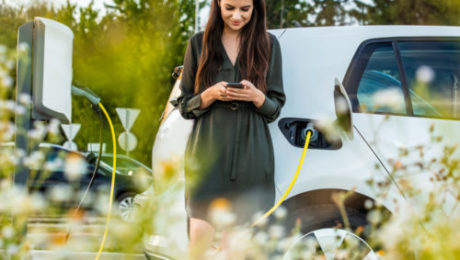Electric Vehicles Present New Insurance Challenges
This article is from RISQ Consulting’s Zywave client portal, a resource available to all RISQ Consulting clients. Please contact your Benefits Consultant or Account Executive for more information or for help setting up your own login.

Electric vehicles (EVs) continue to gain traction in the U.S. auto market. Last year, Americans bought nearly 450,000 EVs—an 83% jump over 2020. With many federal and state governments pushing for lower CO2 roadway emissions, EV demand is expected to soar during the next decade.
This has commercial fleet owners wondering what a world without gas- and diesel-powered vehicles might look like, particularly when it comes to the potential exposures EVs could create. This article discusses the risks that could impact insurance costs for EV fleets.
Unique EV Risks
Because EVs tend to cost more than standard automobiles, their insurance rates are usually higher. However, other factors unique to EVs could also make insuring them costlier. Such factors include:
- Cyberthreats—Like most new cars and trucks, EVs offer connected car technologies such as Wi-Fi, data sharing and semi-autonomous systems that leave them vulnerable to cyberthreats. However, the public charging stations EVs rely on to recharge their batteries add another layer of risk. Charging stations may serve as an entry point for malware attacks, data theft, system outages, bugs and glitches. What’s more, once a data breach occurs in a single vehicle, it may be easier for a malicious party to access the rest of the fleet.
- Battery problems—There are several risks associated with EV batteries that can potentially impact commercial fleets. For example, battery manufacturing defects can lead to large-scale vehicle recalls, putting fleet owners at an increased risk of business delays. Additionally, under certain conditions, lithium-ion batteries that power EVs can ignite or explode. Notably, battery fires burn longer and hotter, release more toxic fumes and liquids, and spread faster over a larger area than traditional fires. Such an incident would create a whole new set of insurance challenges.
- Pedestrian accidents—One selling point of EVs is they run quieter than gasoline-powered vehicles. Unfortunately, this lack of audible engine noise may also put pedestrians at greater risk of being hit if they fail to hear an approaching EV.
Other Considerations
While uncertainty about new EV technologies will likely drive up insurance premiums initially, expectations are that prices will stabilize over the long term. Meanwhile, several other concerns will need to be addressed before EVs become scalable. These include the following:
- Scarcity of repair shops and parts—Very few auto shops can handle EV repairs, so it may be difficult to find timely service. Further, shops that do fix EVs often have trouble locating parts. This is partly because four key elements essential to battery technology—cobalt, graphite, nickel and lithium—are currently in short supply. Even if supplies can eventually catch up with surging demand, EV auto shops will remain at risk for supply-chain delays, as these rare elements are sourced from distant regions all over the globe.
- Costlier repairs—Most EV parts cost significantly more than parts for gas-powered vehicles. Batteries are especially high-priced and vulnerable to harm. An accident that might be a fender-bender on a standard car could result in an EV’s total loss if the battery takes serious damage. Adding to costs, EV repairs usually require more labor hours. This is in part due to EV technology’s increased complexity as well as auto mechanics dealing with the learning curve of working on unfamiliar machinery. As a new generation of technicians gains experience, repair times should shorten.
- Extreme weather concerns—It’s unclear how much of a role extreme weather will play in EV battery performance. Under severely hot temperatures, batteries, on rare occasions, have been known to ignite or explode. Under cold temperatures, batteries hold their charges for a shorter period of time. However, it’s unknown whether these drawbacks are significant enough to make EVs impractical in certain weather conditions or climates.
- High voltage hazard—A number of high-voltage electric cables run throughout the body of EVs. When an accident occurs, exposed cables could cause serious injury to passengers or first responders trying to free crash victims from damaged vehicles.
Conclusion
Although it probably won’t happen overnight, EVs seem positioned to dominate roadways sometime in the near future. Commercial fleet owners who start thinking about EV insurance challenges today will be better positioned to thrive in a post-fossil-fuel landscape.
Contact us today to learn more about insurance for EVs.
- Published in Blog
Quick Tips: Save Money on Energy in Your Household
This article is from RISQ Consulting’s Zywave client portal, a resource available to all RISQ Consulting clients. Please contact your Benefits Consultant or Account Executive for more information or for help setting up your own login.

According to the National Energy Assistance Directors Association, energy costs will reach a decade-long high this winter. Heating costs are predicted to rise 28% for U.S. households relying on natural gas and 27% for those using heating oil. Electricity costs are also anticipated to increase 10% per the U.S. Energy Department. Read on for tips on how you can lower the energy bills for your home.
Why Are Heating Costs Rising?
Many factors have contributed to the rapidly increasing energy costs this year including the following:
- A predicted colder-than-average winter
- Rising wholesale gas prices
- Depleted energy stores from increased demand during the 2020 and 2021 lockdowns
- Lowered supply stemming from financial sanctions put on Russian oil after the invasion of Ukraine
How Can I Reduce Energy Costs in My Household?
With skyrocketing prices, you may be wondering how you can reduce or control your winter utility bills. Many may be tempted to simply turn down the thermostat. Fortunately, there are ways you can lower your energy bills while staying warm this winter.
Here are some tips to help you lower your energy bills:
- Use a programmable thermostat to automatically lower your temperature when you’re not home.
- Seal areas where heat could escape from your windows and doors.
- Ensure radiators and vents are unobstructed.
- Open curtains and windows during the day and close them at night.
- Replace your furnace filter if it’s dirty.
- Have a professional inspect your HVAC systems for leaks.
- Close the vents and shut the doors to rooms you’re not using.
- Consider other sources of energy waste (e.g., leaky faucets, inefficient light bulbs).
Cold weather may make some increased energy costs inevitable. By using the above tips, and consulting the Department of Energy’s Energy Saver Guide, you can be well on your way to managing your winter utility bill.
For additional winter home safety tips, contact us today.
- Published in Blog
Fuel Efficiency Best Practices for Fleets
This article is from RISQ Consulting’s Zywave client portal, a resource available to all RISQ Consulting clients. Please contact your Benefits Consultant or Account Executive for more information or for help setting up your own login.
Improving the fuel efficiency of a company’s fleet of vehicles can have many financial and environmental benefits, especially with fuel prices on the rise. Fuel can be one of the largest and most difficult expenses to predict and control. Therefore, it’s important for vehicle fleet managers to conserve fuel, maximize efficiency and reduce vehicle emissions by implementing fuel-efficient policies, technology and maintenance strategies.
Best Practices
Managing a fleet’s fuel usage—even for just a couple of vehicles—can feel overwhelming. The following are ways to reduce fleet fuel costs and make operations more efficient:
- Monitor driving patterns. A U.S. Department of Transportation report found that there can be as much as a 35% difference in fuel consumption between a good and poor driver. Monitoring speeding, braking and acceleration patterns can indicate whether drivers are using good practices on the road or operating inefficiently.
- Cut engine idling. Idling can burn a quarter to a half gallons of fuel per hour. To reduce fuel and oil waste:
- Turn off the engine while waiting or making deliveries.
- Turn off the engine while stuck in traffic.
- Do not idle to warm up the engine.
- Improve route efficiency. Route efficiency can be improved with GPS tracking technology to ensure operations are streamlined and drivers don’t spend their day and fuel driving back and forth.
- Remove unnecessary weight from vehicles. Every extra 100 pounds in a vehicle can increase gas costs by up to $0.03 cents per gallon, which can quickly add up over the course of hundreds of thousands of gallons across multiple vehicles. Only travel with necessary packages or equipment.
- Schedule maintenance. Preventive and regular maintenance can reduce fuel costs, extend the lifespan of fleet vehicles and ensure the safety of drivers and the community.
- Check the tire pressure. Tires should be inflated to 75% of the recommended pressure; underinflated tires can significantly lower a vehicle’s average gas mileage. Checking the tire pressure should be a mandatory part of the pre-trip safety check since it not only improves the cost per mile but also helps the vehicle respond properly in unsafe situations.
- Dispatch the closest vehicle. Business margins and fuel efficiency can be improved by dispatching the closest vehicle to a new delivery or appointment. Fleet-tracking programs can help automate dispatching and routing.
- Leverage a fleet telematics solution. A fleet telematics solution can help managers gain data and insight into fleet status in terms of individual vehicle performance and overall operations, allowing them to make changes that will help fuel efficiency.
- Provide incentives. Fleet managers can encourage efficient driving by offering drivers incentives, such as recognition or special privileges.
- Implement driver training. Providing drivers with training regarding fuel-efficient habits can increase their awareness of fuel efficiency on the road. It can help them be mindful of things like keeping gears low when accelerating, changing gears early, driving at slower speeds and learning to read the road more effectively.
By implementing policies and practices that monitor and reward fuel-efficient behavior, fleet operations can reduce fuel costs. For more risk management guidance, contact us today.
- Published in Blog




